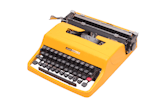Hi there! Thank you for taking the time to leave a review. We're so glad to hear that our Olivetti Typewriter Bag met your expectations. Happy travelling & typing!
Worked perfectly and great improvement over previous ribbon.
We. Are. Obsessed! The customer service, the extra care and thought put into it because it was a surprise/gift was unexpected. Not only that, it came very well packaged, and with a manual copy and everything! We love it so very much, thank you thank you! Now we just need to figure out a name for it <3
Thank you for your kind words! We are so happy to hear that you are happy with your new Olivetti Lettera 35 Yellow Vintage typewriter. We always strive to provide excellent customer service and are thrilled that you appreciate the extra care we put into your surprise/gift. It was our pleasure to do bussines with You. Have fun naming your new typewriter and happy typing! :) P.S maybe good name is OLI? ; )
Absolutely love it! Types beautifully. Shipping took 3 months though.
Thank you for your assistance. Instructions included are a nice touch.
Slim. Racy. Shiny chrome fenders. If we're going back to the Fifties, I plan to fake it 'til we make it: typing recipe cards and indexes, letters and notes-to-self. Thank you for your service with a smile.
I would like to highly recommend this vendor, the product arrived as described and on time. I needed it to arrive by a certain time for a birthday gift and they were accommodating and responsive. The typewriter arrived on time and beautifully wrapped, even with a little typed “Happy Birthday” note. I'm very pleased with the purchase and would without question buy from them again - thank you so so very much!!!
My Olivetti typewriter was delayed in shipping (through no fault of the seller) but when it arrived it was expertly packaged for shipping and arrived in excellent condition. When I contacted the seller about the delay in its arrival, the customer service immediately contacted the shipper and they were able to give me an updated estimate on the arrival date.
The typewriter is beautiful and fun to use.
One of the most amazing sellers I have ever worked with they packaged amazingly and made it so special for my wife birthday thank you so much would recommend to anyone looking for an amazing seller
Hi Gabriel Thank you so much for your kind words and for choosing to purchase from us! We are thrilled to hear that you had a positive experience and that you were happy with the packaging and overall service. We truly appreciate your recommendation and are always here to provide top-notch service. Thank you again for your supporting small family business and we hope your wife enjoys her new Olympia Monica typewriter. Have a great day! Sending ❤️ from Spain
Shipping took longer than expected. But this cover fits my Olivetti Pluma 22 perfectly and is very high quality!
This is an absolutely stunning typewriter! It is in excellent condition, and the sellers included a Tolkien quote and a cute typewriter pin! It comes with an instruction manual, which was helpful as this is my first typewriter.
The shipping to the USA took approximately 1.5 months longer than predicted. I don't blame the sellers for this, as they posted the typewriter in the post VERY quickly. The wait was worth it. Fortunately this typewriter just for personal use - if purchased as a gift, buy VERY early.
The only bummer was the installed typewriter ribbon being almost completely dried out - I purchased a new typewriter ribbon today but am sad that I can't use my typewriter until it arrives.
The sellers are AMAZING. They have been very helpful and kind. This is the only shop I'd consider for purchasing a typewriter.
Ottimo venditore, descrizione oggetto fatta in maniera perfetta
The typewriter is great. Still learning about it and getting used to it. Happy overall.
Anita and Jacek were determined to make sure the typewriter arrived safely, and they took the time to call and troubleshoot some shilling issues. When the typewriter finally arrived, it was everything I hoped it would be. It was in beautiful condition and worked like a dream. I can't wait to get full use out of it!
Parfait, je ne suis pas déçu, très heureuse même. Très bien emballé, respect de la livraison et qualité du produit impeccable.
The typewriter is gorgeous and it made my Mom the happiest, she loves it.
This typewriter is absolutely amazing and it was immaculately packed. There were some issues with fed ex but it was nothing to do with the seller. The sellers are very kind and patient and had no problems accommodating me and kept me updated all of the way!
The whole experience was so outstanding that I don't know where to start. My typewriter is incredible, in extraordinary good shape, packaged with lots of care. I had the typewriter delivered to the hotel where I was staying in Madrid and the whole shipping process was very smooth and the communication with the store super efficient and friendly. I will buy from them again!
The product is very well crafted, it fits perfectly on my Olivetti Lettera 32
So nice that these are still out there! I have a happy daughter typing away on her Baby Hermes. You have contributed to more written dreams and stories ;)
Love this dust cover for my typewriter. It is very well made and the material is high quality and it will probably last a very long time. Very pleased!

















































